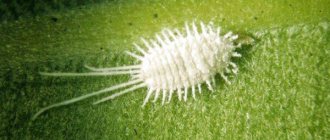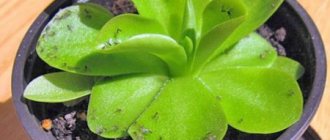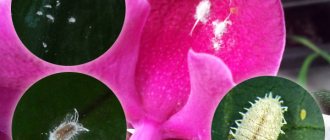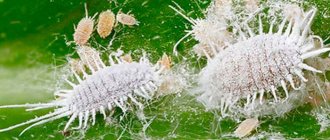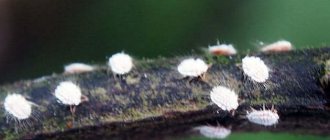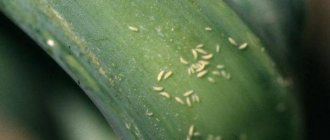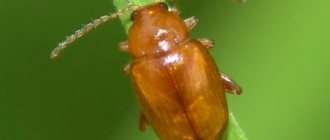Exotic orchids, previously unknown in our country, are increasingly being bred by fans of this flower on their windowsills. Despite the external vulnerability and fragility of the roots, these plants easily adapt to new conditions and tolerate the dry climate of apartments well. However, they are also susceptible to diseases and attacks from harmful insects. The most common one is the mealybug.
There is a lot of information about this pest on the Internet, accompanied by photos and videos. What to do if a mealybug appears on an orchid, how to get rid of it using the most effective methods - find out from this article. It is important to remember that it is impossible to cure a plant from a parasite. You just have to fight it: remove it, destroy it, and then take careful precautions so that it doesn’t appear again.
Reasons for appearance on indoor flowers
For the most part, insect attacks on orchids occur in winter. This is due to metabolic disorders in plants due to lack of sunlight. In addition, there are several other causes of insect damage:
- incorrectly selected seasonal temperature regime;
- low indoor air humidity;
- excess nitrogen content in the substrate;
- untimely removal of dead leaves from the plant;
- non-compliance with the irrigation regime, which led to waterlogging;
- lack of water procedures.
Mealybugs can get indoors along with new plants or when purchasing soil.
As a rule, the likelihood of being affected by these pests is high in weakened specimens.
Signs of a pest. How to detect it?
There are two types of mealybugs that attack orchids: bristly and citrus . The first species feeds on the leaves and shoots of the plant, the second attacks the flower at the roots. The pests are shaggy white bugs, very small in size (females 3–5.5 mm, males 1.5–2 mm), have an elongated, rounded body shape and are covered with white threads. The larvae look like small yellowish worms.
A careful inspection of the plant will help identify the presence of a dangerous parasite. Orchid owners should be wary if the flower :
- the shape of the leaves, stems or flowers is deformed;
- there are areas of dark gray color on the leaves or stem;
- the inside of the leaf is covered with a sticky substance;
- in the places where flowers and leaves are attached to the stem, thin white threads were found;
- Ash-colored lumps appeared on the soil.
Varieties and descriptions with photos
Of the numerous representatives of scale insects, several species cause particular concern to gardeners.
Citrus
Pseudococcus calceolariae. It is distinguished by a light crimson body covered with white wax, and the presence of 17 pairs of posterior wax filaments, the size of which is a third of the length of the entire body. Adult females reach up to 4.5 mm in length and 2.5 mm in width.
Bristly
Pseudococcus longispinus. It has a flat, elongated oval body with a gray-yellow or greenish tint, covered with white powdery wax. Forms a cotton wool-like mesh that shelters the larvae.
Seaside
Pseudococcus affinis is characterized by a light gray or pink oval body, 5 mm long and 3 mm wide, and well-developed legs. Males fly throughout the summer.
Grape
Pseudococcus citri - has an oval body 4 mm long and 3 mm wide, the shade of which varies from pink to greenish. Of the 18 pairs of wax filaments, increasing towards the posterior end of the body, the last one is the longest.
Description of the flower pest
This pest is small in size, no more than 6 mm in length. Their body is oval, with a slightly noticeable waxy coating. At the end of the body there are noticeable plates of different lengths. The body color is white or beige. The body is covered with small bristles, and on the back there are grooves located across the body.
Mealybugs are mobile at different ages; they can easily move along plant shoots, descend into nutritious soil mixture, and move to other flowers in the room.
The photo shows a mealybug on an orchid:
Males and females are different from each other. Adult male mealybugs have wings but no mouthparts
, since they do not feed at all: they mate and then die.
Females do not have wings, they live in large colonies
. They pierce the leaf blades with a long proboscis and suck out the cell sap. First, the females make cotton-like sacs in which they lay their eggs.
On the foliage, such bags look like plaque - this is the first symptom of the appearance of scale insects on orchids.
Each female can bring up to 4 generations per season
. After emerging from the eggs, the larvae actively crawl through the orchids. They look like fluff and are light gray in color. Having found a convenient place, they attach themselves to the orchid and begin to feed on cell sap. After molting, adults begin to look for another place.
Important!
Females can also lay eggs in the soil near flowers, and the hatched larvae will find their way to the flowers themselves.
Most often, mealybugs on orchids live and feed in the axils of the leaves. Adult females usually live in flowers or buds. When a colony of females becomes too large, the flowers become deformed and the foliage becomes marbled.
Orchids damaged by this pest become weaker and therefore can be affected by various diseases. The waste products of these pests get inside the shoots and flowers, slowing down the metabolic process in orchids.
Signs of infection
The presence of a mealybug will be indicated by the following signs:
- the presence of a white coating on the leaf blades, buds and shoots, similar in appearance to powder;
- the appearance of shine and stickiness on the leaves due to the secretion of sweet nectar by the larvae - honey dew;
- deformation of flowers and buds (with prolonged parasitism);
- curling of young shoots;
- the formation of peculiar lumps on the plant, reminiscent of fluff or cotton wool.
An orchid affected by a mealybug is deprived of nutrients, which causes rapid depletion and death.
How mealybug attacks orchids - signs and consequences of infection
The mealybug and its larvae prefer to feed on the sap of young leaves; they love the current year's shoots, as well as their buds.
The main symptoms of the appearance of this pest on orchids are:
- the formation of white plaque on the foliage;
- sugary sweet honeydew that appears on plants.
It must be remembered that citrus bugs affect not only the above-ground part of orchids, but also their root system.
How to get rid of it: pest control measures
If a mealybug is detected on an orchid, several actions must be taken immediately:
- Cut off and destroy flower stalks with buds.
- Remove pests from the affected parts of the plant using a toothpick or tweezers.
- Treat the leaf blades with a cotton pad soaked in alcohol or calendula tincture.
In some varieties, young scale insects prefer to settle under the young scales covering the pseudobulbs. In this case, the scales must be removed, and the pseudobulb must be treated with a sponge, which allows you to eliminate individuals that are not yet visible to the eye. If the leaves of the plant are affected, they are also removed.
Next, you need to process the flower.
Types of scale insects that are dangerous for orchids
There are 7 species of scale insects. However, only 2 of them affect the orchid:
- Citrus. The female is pink in color and secretes liquid. Life expectancy is 3 months. After 2 weeks of life it is able to lay eggs. The male can fly and lives 4 days.
- Bristly. Females are presented in red, with a white coating present. Males are gray in color and have transparent wings. Pests are able to secrete a liquid that protects them from the negative effects of the external environment.
Treatment with folk remedies
You can fight mealybugs not only with the help of chemicals, but also with folk remedies. Their use has the following advantages:
- availability;
- absence of aggressive components;
- environmental cleanliness.
However, this option is recommended only if the pest is timely detected and has not yet had time to reproduce.
The most common folk recipes:
- Soap solution. For this purpose, it is best to use green soap. To prepare, dissolve 15 g of soap in 1 liter of water, then treat the orchid at least 3 times with an interval of 7 days. Wash off the solution 24 hours after each use. You can enhance the effect of the working composition by adding 2 tbsp. l. vodka or 1 tbsp. l. alcohol
- Tinctures of medicinal herbs (horsetail, calendula). Pour boiling water (100 g/1 l) over the herb, let it steep, pour into a spray bottle and spray on the affected orchid.
- Composition of olive oil and water. Mix the components in a ratio of 2 tbsp. l. per 1 liter and treat the plant with it using a spray bottle. After approximately 2 hours, wash off the working composition.
- Garlic infusion. Crush 6 garlic cloves and pour boiling water over them. Leave for 4 hours, filter and apply to the affected parts of the plant using a soft cloth.
- Hot shower. The water temperature should be about 30 degrees. The pot with the flower is placed in the bathroom and the plant is poured out of the shower for 15 minutes. After which it is necessary to remove all moisture from the axils of the orchid using a paper napkin.
Mealybug on an orchid: methods of control
When a mealybug appears on an orchid, the question arises - how to get rid of this pest quickly. But we must remember that this insect is capable of secreting wax in large quantities if it is in danger. This substance completely protects the insects from chemicals and other means that are used to kill them.
Salicylic Acid for Mealybug
A special bag of fibers, which is “made” by female mealybugs, protects the eggs laid in it.
Therefore, if traces of these harmful insects are found on orchids, all affected flowers must be isolated in a separate room.
When a mealybug appears on orchids, control measures must be chosen depending on how large the colony of these pests is.
Effective folk methods for mealybugs on orchids
If pests appear on shoots, buds or flowers, they should all be cut off and burned
. All pseudobulbs that appear must also be removed, and the bulbs must be wiped with a cotton pad soaked in alcohol. Otherwise, it will not be possible to remove small larvae from plants.
The main effective folk remedies for combating scale insects are prepared on the basis of laundry soap, alcohol tincture or oils.
A soapy solution for mealybugs is prepared as follows:
: dissolve 40 g of grated laundry soap and 2 tbsp in 2 liters of heated water. l. alcohol All components are mixed until the soap is completely dissolved.
Use a cotton pad soaked in this working fluid to wipe all above-ground parts of the orchids. Particularly carefully wipe those places where there was a sac with a clutch of mealyworm eggs.
You can also spray orchids with an infusion made from horsetail.
. It can be purchased in specialized stores. Before processing, this infusion is diluted in water in a 1:1 ratio.
Garlic infusion is also very effective against most pests that attack orchids.
. It is prepared in the following way: several large garlic cloves are poured with 5 ml of boiling water and left to steep for 3-5 hours.
Then the resulting infusion is filtered and applied to the plants with a special brush, which after treatment must be rinsed under running water and disinfected. The window sill where the flowers stood and the pots themselves are simultaneously treated with a soap solution.
Efficiency of mechanical cleaning
Parasites and egg sacs should be removed by hand first
. To do this, it is better to use tweezers. Everything collected must be destroyed immediately.
The parts of the plants where the pests were located must be wiped with alcohol, then the plant is washed under running water.
. Such a shower will wash away the sweet secretions, as well as some of the pests from the orchid. The foliage is wiped with a piece of cotton wool soaked in a soap solution.
Mealybug on an orchid. How to get rid
All indoor plants that stood next to the flower damaged by the insect must be carefully examined within 25-30 days.
At the first symptoms of the appearance of a scale insect, they should also begin to be treated.
Heavy Artillery - Chemicals
Chemicals are used to combat scale insects if folk remedies are ineffective. It is necessary to use such insecticides at the moment when the larvae have just hatched from the testicles and are not yet covered with a coating of wax. It is at this moment that they are most vulnerable, so they can be dealt with using chemicals.
What to do if there is a mealybug on an orchid
The fight against this pest is often difficult due to the fact that mealybugs at different stages of development can simultaneously be present on the plant.
. And a single treatment with chemicals can only cope with part of the scale insects - their larvae. Therefore, several sprayings are usually carried out, the interval between which should be 12-14 days.
Typically, sprayed drugs quickly penetrate into the foliage and shoots, and the poisoned cell sap enters the body of the insects, paralyzing them, as a result, adults and larvae quickly die.
Advice!
If the eggs were laid on the roots of the orchid, then the biological product Fitoverm can destroy them. It is safe for people and pets, and kills pests within 2-3 hours after treatment.
The following drugs work best against scale insects:
- Aktara;
- Mospilan;
- Aktellik;
- Calypso.
Any of these drugs should be diluted strictly according to the instructions, without exceeding the indicated dosage. Most insecticides protect plants for 25-30 days after treatment.
Chemicals: how to treat?
Modern manufacturers present a variety of chemical preparations that can effectively eliminate pests on indoor plants. The advantages of using them are as follows:
- the ability to quickly penetrate orchid juice, making it poisonous;
- creation of reliable protection for a relatively long period;
- the ability to eliminate parasites in hard-to-reach places.
Disadvantages of chemicals:
- high toxicity to people and pets;
- causing addiction of some drugs in mealybugs.
The most popular chemicals among gardeners include:
Aktellik
Created on the basis of pirimiphosmethyl. Getting into the body of scale insects with plant juice, it has a detrimental effect on them.
Due to high toxicity, it is not suitable for preventive treatments.
Fitoverm
Insectoacaricide of biological origin. Due to the lack of toxicity, it is ideal for treating indoor plants. Has a contact-intestinal spectrum of action.
Aktara
Made from thiamethoxam. Penetrating inside the leaf plates, it infects pests during feeding. Characterized by high power of action. Involves processing up to 4 times with an interval of 10 days.
Calypso
Created on the basis of thiacloprid. Blocks the transmission of nerve impulses of parasites, which causes their death. It is considered an intestinal and contact insecticide.
Treatment with the drug is carried out up to 2 times with an interval of 40 days.
Bankol
A drug based on bensultap. Kills pests through direct contact or feeding. Not recommended for use during flowering.
Mospiplan
Contains acetamiprid and is not addictive to parasites. It has a contact-intestinal effect and provides protection for 3 weeks.
Features of different types of mealybug
There are many types of this pest, but only a few of them “attack” indoor flowers:
- Mealybug bristly
. Orchids are damaged only by larvae and adult female scale insects. In adult insects, the body has an orange or pink color with a powdery coating. The length of the female body is 5 mm, and the males have a smaller body. The main symptom of the appearance of mealybugs on orchids is the appearance of sweet honeydew on the foliage, secreted by these pests. Bristlebugs are viviparous; larvae and adults can actively crawl along the shoots of these flowers. - Primorye mealybugs
most often appear on orchids. The body of females is elongated and pinkish-gray in color. The body is covered with a characteristic powdery coating. Males have a body length of about 2 mm, they have wings to move from plant to plant. The body length of the wingless female is more than 4 mm. Females have well-developed limbs, thanks to which they easily move in search of food or a place to lay eggs. - Citrus mealybugs
. The body color of these insects ranges from yellowish to brownish, a waxy coating is clearly visible on the body, and thick bristles on the sides. The females' secretions are sticky and sweet.
What to do for prevention?
Compliance with preventive measures allows gardeners to significantly reduce the risk of orchids being damaged by mealybugs. To do this, the following is recommended:
- Carefully inspect the plant when purchasing.
- Maintain the necessary air humidity and lighting in the room.
- Follow the watering and fertilizing regime.
- Trim dried fragments in a timely manner.
- Periodically inspect plants for lesions.
Prevention measures
To protect plants from insects, it is necessary to carefully inspect the flowers when purchasing them.
The occurrence of pests can be prevented if the recommended conditions for keeping plants are observed. First of all, orchids need good lighting. If necessary, you can install a lamp.
Dry leaves may contain pests. Therefore, you should get rid of them immediately.
Scale insects have a negative attitude towards fresh air. It is necessary to create high humidity around the plants. To do this, you need to regularly wipe the leaves and take a warm shower. After the procedure, excess moisture should be blotted with a napkin. This is done in order to avoid the formation of rot.
Appearance
Mealybugs are sucking insects that are clearly visible to the naked eye on the plant due to the cotton-like waxy coating they secrete. The sizes of adult individuals are from 0.5 to 12 mm. Adult males have a pair of wings and can fly from one flower to another, but do no harm. They have no mouthparts, do not feed and live for 2–4 days, dying immediately after mating with a female.
Females and larvae suck the juice from plant cells; damaged orchid organs, depending on the degree of damage, are stunted in growth or die completely. Insects are very mobile; the larvae change their location as they develop. Their white, pinkish or light brownish oval body is as if sprinkled with flour powder; wax plates often protrude along the edges.
They reproduce by laying yellowish eggs in a white cotton-like pouch. In some varieties, females are viviparous. In one season, 2–4 generations of pests develop. Oviposition is established in secluded places of the plant - leaf axils, inside buds, on the underside of leaf blades, among the roots.
Reviews
Liberman Sofia, 35 years old, Sochi
My passion for orchids began last year. At work I was given a bright yellow Phalaenopsis orchid. It bloomed for me for probably about 2 months. I was simply amazed at the beauty of its flowers, but one day on the leaves, I noticed small white balls that looked like lumps of cotton wool. At first I didn’t pay attention to this. I just removed them and that's it. But a few days later, on the inside of the leaves, I saw that there were about 5 such balls. I immediately went online. I already realized that my favorite orchid was overcome by a mealybug. First, I removed all the insects and treated the places where they were with an alcohol solution. But this didn’t really change the situation; after a few weeks, these cotton balls began to appear on her again. In a word, I was able to overcome this scourge only with the help of purchased insecticide.
Dmitrova Elizaveta, 27 years old, Vologda
Unfortunately, I am familiar with the problem of mealybugs firsthand, since all my orchids suffered from this disease. At first, probably like all novice flower growers, I thought that I would be able to overcome the bugs on the leaves with just a soap solution, but a miracle did not happen. I treated my favorite orchids 4 times a week with a soap solution. To do this, I had to take old Soviet laundry soap from my grandmother. Yes, it had an invigorating smell, of course)) But what to do, I had to prepare a soap solution. I sprayed not only the leaves and flowers, but also the roots. I understood that all my efforts were pointless, since the white sacs of the insect appeared again and again on the leaves. Therefore, I decided to fight this problem with the help of Aktara. For this purpose I made a solution. I sprayed flowers and leaves with it. I also disinfected the substrate in it. After this treatment, the pests became significantly smaller, but after 2 weeks I repeated this procedure again. As a result, in 1.5 months I managed to destroy the mealybug on my orchids!
Konstantinovich Ekaterina, 38 years old, Tula
I can’t help but tell you about my story of fighting mealybugs on orchids. I first learned about this pest only 2 years after the orchid first appeared at my home. For the first 2 years, the Phalaenopsis orchid delighted me with its large flowers, but in the third year it froze in growth. I already bought fertilizer, I thought that she lacked nutrients. To help it recover faster, I fed the orchid once a week for 2 months. As it turned out, such frequent feedings provoked the appearance of mealybugs on the plant. I learned about this from the flower shop sellers. It turned out that my efforts turned out to be such a misfortune for the orchid. But I decided not to give up. I began to save my favorite flower from pests using all proven methods.
First I removed all the insects. I did not process the places where they were located, since there were quite a lot of them. The orchid has completely stopped growing and forming new young roots and flower stalks. Therefore, I decided to approach the problem in a comprehensive manner. I sprayed the plant with a solution of the insecticide Actilik 3 times a week. The duration of this treatment for my orchid was 2 months. In addition, I changed the substrate and pot.
Prevention
By following the basic rules for caring for orchids and taking preventive measures, you will already protect your plant from mealybugs by 90 percent. If the plant is healthy, then caring for it will not be difficult; the main thing is the correct regime for maintaining the orchid, normal watering and prevention from diseases and pests. The whole complex of these works can be divided into the following points:
- once a month, even a healthy orchid should “take a shower”, bathe it under low pressure from a shower net, the water can be at room temperature or a little warmer, make drainage holes in the pots to drain water from the root system;
- Once every 2 weeks it is necessary to wipe the orchid leaves and axillary areas with an antiseptic: hydrogen peroxide solution, soda solution, succinic acid or other preparations.
- The main rule for proper care of orchids is to maintain normal watering; you should not overwater the plant or allow the soil surface to dry out. In winter, the flower is in a state of relative dormancy, it does not require abundant watering, it is done no more than once a week, in spring and summer the amount of watering is increased to 2-3 times every 10 days;
- Another important condition will be the temperature and humidity of the air in the room; excessive heat or especially low temperatures have a detrimental effect on the condition of the orchid; it cannot tolerate either one, it becomes weak, lethargic and does not bloom. In this state, the orchid is susceptible to infection with various diseases and attack by mealybugs. To summarize, the main thing in prevention is: plant hygiene, preventive treatment, correct watering regime, temperature and humidity.
There are many other means to help kill mealybugs on orchids. In the fight against a pest, you cannot despair and give up; if you do not give up in this fight in front of an insignificant insect, then everything will be fine, and your orchid will delight you and your family for a long time, decorate the interior of your home and create coziness and comfort in it.
How to treat an orchid against mealybugs at home is up to the gardener to decide. Plant diseases are always unpleasant. Therefore, it is important to take timely measures. Aktara is an excellent remedy if you need to get rid of a pest. The consumption of the drug depends on the number of plants that need to be treated. Mealbug control must be comprehensive.
